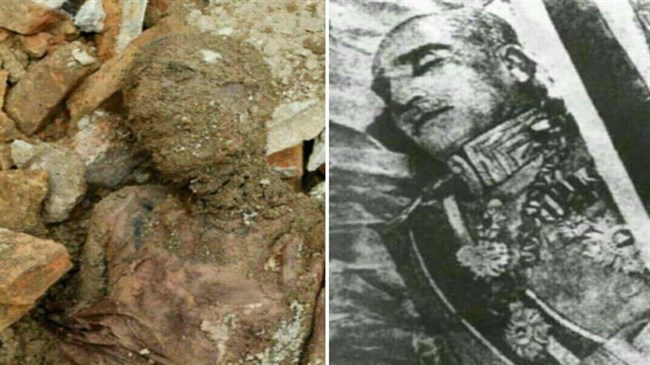May 26, 2018

Construction workers have unearthed the mummi-fied remains of a body near the destroyed mausoleum of Reza Shah and there is widespread speculation the mummy may be that of Reza Shah
Reza Shah’s mausoleum was razed by revolutionaries in 1979, but they found no corpse in it.
The recent find of the gauze-wrapped body has triggered intense speculation and revived discussion of Iran’s monarchial past. The monarchy’s widespread abuses did much to fuel the revolution, but its mystique persists and some protesters at recent demonstrations have been heard to chant paeans to Reza Shah, who started Iran’s modernization.
Reza Shah’s grandson, the US-based Reza Pahlavi, has tweeted that he believes the remains to be those of his grandfather.
Workers discovered the mummified remains while on a project at the shrine of Abdul Azim, whose minarets rise beside the site where Reza Shah’s mausoleum once stood south of Tehran. A digger pulling away dirt and debris uncovered the body April 23, according to the Iranian Students News Agency (ISNA).
Pictures of the mummy have filled social media.
On April 25, according to the Center for Human Rights in Iran, police arrested more than 10 curious people who had come to the site.
A spokesman for the shrine dismissed the idea that the mummy was Reza Shah’s. However, Hassan Khalilabadi, the head of Tehran City Council’s cultural heritage and tourism committee, was quoted by the state news agency as saying it’s “possible” the mummy is the body of Reza Shah.
Authorities say they’ll need to conduct DNA tests to confirm whether that is true.
State broadcasting has not been heard reporting anything on its newscast, but it normally only carries news about the Pahlavis that portrays them as wicked or depraved.
Reza Shah came to power in 1925, ruling as an absolute autocrat but rapidly modernizing the state and the economy by setting the country on the road to industrialization.
Iran’s strong trade ties with Germany, Reza Shah’s push for neutrality in World War II and Western fears of its oil supplies falling to the Nazis ultimately sparked a Russian-British invasion of the country in 1941. Reza Shah abdicated in favor of his son, Mohammad Reza Pahlavi, at the insistence of the occupying British forces.
Reza Shah died in South Africa in 1944. His body was taken to Cairo, mummified and remained there for years before being brought to Iran and reburial in the mausoleum.
After the revolution, Ayatollah Sadeq Khalkhali, who ordered the executions of hundreds, led a mob of supporters who used sledgehammers and jackhammers to demolish the mausoleum. They found no body, however.
Khalkhali later would write in his memoirs that he believed the Shah’s family took Reza Shah’s body when they fled the country. The Shah’s family, however, maintained the body remained in Iran. His son, Mohammad Reza Pahlavi, was buried in Cairo after dying there of cancer in 1980.